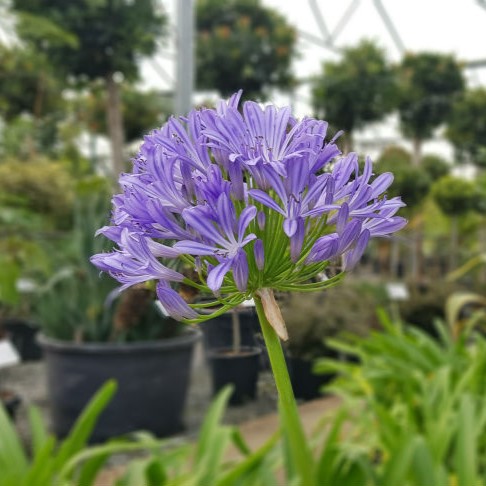Growing Agapanthus: A Total Overview to Beautiful Blooms
Growing Agapanthus: A Total Overview to Beautiful Blooms
Blog Article
Grasping the Art of Agapanthus Treatment: Essential Steps for Healthy Development and Vibrant Blossoms
In the world of horticulture, the growing of agapanthus stands as a rewarding endeavor for those who look for to nurture these elegant flowering plants. With their striking blooms and graceful foliage, agapanthus has actually captured the attention of gardeners worldwide. However, accomplishing ideal growth and vibrant blooms calls for a nuanced approach that incorporates numerous necessary actions. From picking the appropriate variety to mastering trimming strategies, the trip in the direction of cultivating growing agapanthus plants is complex and holds the key to unlocking the complete capacity of these herb gems.

Picking the Right Agapanthus Range

When selecting the appropriate Agapanthus variety for your yard, take into consideration variables such as environment suitability, flower color, and growth routine. In addition, take into consideration the climate in your area to make certain the Agapanthus range you select can thrive in your specific conditions. Comprehending the growth behavior of various Agapanthus ranges is vital for proper placement within your yard.
Suitable Growing Problems
Thinking about the optimal ecological demands is vital for effective Agapanthus cultivation. Agapanthus grows in well-draining dirt with a slightly acidic to neutral pH level. When planting, select an area that receives complete sunlight to partial color. In hotter environments, supplying some mid-day color can stop scorching of the leaves. Agapanthus plants are delicate to cool temperatures and need to be protected from frost throughout winter months.
To make sure healthy and balanced development and vibrant blossoms, plant Agapanthus light bulbs at a deepness of concerning 2-4 inches and space them 8-12 inches apart. Mulching around the base of the plants assists maintain moisture and suppresses weed development.
Watering and Fertilizing Tips
Maintaining proper wetness degrees and offering essential nutrients are vital elements in the treatment program for Agapanthus plants. When it comes to sprinkling Agapanthus, it is important to strike an equilibrium. These plants choose consistently wet dirt however are prone to root rot if overwatered.
Feeding Agapanthus is important for promoting healthy and balanced development and respected blooms. Use a balanced fertilizer, such as a 10-10-10 formula, in the very early spring as brand-new development arises. By adhering to these watering and fertilizing ideas, you can ensure your Agapanthus plants prosper and produce lively, long-lasting flowers.
Trimming Techniques for Agapanthus
Pruning Agapanthus plants at the proper times and with proper methods is crucial for preserving their health and wellness and advertising optimal development and blooming. The perfect time to trim Agapanthus is in late winter or early springtime prior to new development arises. Begin by eliminating any type of yellowing or dead fallen leaves near the base of the plant. Cut them as close to the ground as feasible without harming the arising shoots.
For flowered stems, wait up until the flowers have perished and then cut them back to the base. This not just cleans up the plant's look yet also urges the advancement of new blossom buds. Deadheading invested blossoms can additionally reroute the plant's energy into producing more blossoms instead of setting seeds. However, if you wish to collect seeds for propagation, leave some blossoms to fully grown and dry on the plant.
Bear in mind to utilize clean, sharp devices to make accurate cuts and lower the danger of introducing conditions. Agapanthus. Normal pruning will certainly assist keep your Agapanthus looking healthy and cool while making sure a bountiful display screen of beautiful flowers
Dealing With Typical Bugs and Illness
After making certain appropriate pruning strategies for Agapanthus, it is necessary to address usual insects and illness that can impact the health and vitality of these plants. Agapanthus plants are normally hardy but can still fall victim to particular issues. One usual pest that impacts Agapanthus is the Agapanthus gall midget. This tiny, orange fly lays its eggs in the foliage, bring about distorted development and flower buds that her latest blog stop working to open. To fight this pest, trim and ruin any type of affected plant components and think about using insecticidal soap.
Additionally, Agapanthus plants can experience from origin rot if they are grown in inadequately draining pipes soil. By being cautious and taking timely action versus bugs and illness, you can aid your Agapanthus plants prosper and create dynamic blossoms. Agapanthus.

Verdict
To conclude, mastering the art of agapanthus care entails picking the right range, offering official website perfect growing problems, appropriate watering and feeding, proper pruning strategies, and attending to usual insects and diseases. By adhering to these vital steps, you can make certain healthy growth and lively flowers for your visit site agapanthus plants. Bear in mind to routinely check and preserve your plants to advertise their general health and long life.
To make certain healthy and balanced growth and vivid blossoms, plant Agapanthus bulbs at a depth of concerning 2-4 inches and area them 8-12 inches apart. By following these watering and feeding pointers, you can ensure your Agapanthus plants thrive and produce vivid, lasting blooms.
One typical pest that influences Agapanthus is the Agapanthus gall midge. In addition, Agapanthus plants can experience from root rot if they are planted in inadequately draining dirt. By adhering to these essential steps, you can make certain healthy development and dynamic flowers for your agapanthus plants.
Report this page